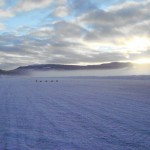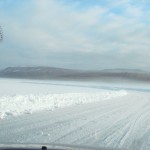A couple of busy days later, I finally find time to upload a couple or three photos of the lake at Alvdalen. But it’s time for bed so I’ll have to fill in the details later!
And here are the details.
After another four-thirty alarm, I drove to Stansted in the pouring rain, left my car with a delighted parking attendant and checked in. And all before coffee, which I find remarkable. My traveling companions were Mark and Mike, both IT consultants and David, a dentist: all easily identifiable as fanatics by the stack of car mags in their bags.
We flew in to Skavsta, which is to the south-west of Stockholm and picked up our hire car: a Saab 95 2.0t estate, which by the way, is an excellent car with a whole lot of space. With four trained drivers, the journey north to Alvdalen was very pleasant, but contrary to previous years, the roads were largely tarmac coloured. I managed to get the graveyard shift at the end, which although only 45 minutes out of an almost six hour trip, was had by far the most interesting conditions. Here the roads were white and it was now dark, but the car was capable and we made good progress to the hotel.
At the hotel were the other three members of our group, Simon, Richard and Victoria, but also the previous group of friends which made for an excellent evening full of discursive conversation. Also present were our host and trainers from Volvo: Bert, Jerry and Tomas basically think we’re weird as, despite meeting a large number of highly committed drivers and test-drivers every year, we are apparently the only group that can spend the evenings discussing steering methods or the optimal order in which to train novice drivers in advanced driving techniques.
Out on the ice the next day, they were also surprised. They expect a very high standard of driving from this group, but despite having four ‘ice wirgins’, they didn’t have to pull a single car out of the bank in the whole day.
I should explain: we are on both a test track and a lake (with a frozen surface about half a metre thick), which are to all intents and purposes, low grip. Not slippery enough that you have to fight for balance (although Victoria did slip over a couple of times) but enough that you will stand stock still with your wheels spinning beneath you if you are too boisterous with the gas on take-off. The tracks are created at the beginning of the season by compacting the snow and they are then lovingly cleared, groomed and tended-to by Benny each night, much like a piste, so that all the car makers, tyre manufacturers and test drivers using the track have optimal conditions.
The exercises we were doing were designed to challenge our control over the cars, pushing us to experience cornering, braking and avoiding obstacles at relatively high speeds. The winter tyres that the Swedes use are studded in the main, which is a very good thing: the reason that the UK grinds to a halt in an inch of snow is because we drive on summer tyres – in northern European terms, these are the prevalent conditions that we face.
With summer tyres, a corner that might be comfortable on studs at 40mph would only be possible at 10mph without a loss of control. I know from experience that in very low grip conditions (on Mira wet-grip test-track) I can drive my car neatly round a corner at 10mph or slide it sideways under control at 12-15mph, but I am totally out of control at 17mph… the window is a really small one! The problems really start to pile up for someone driving in UK snow when they think that sufficient grip extends beyond about 10mph… or beyond an almost horizontal gradient!
During the course we get to drive a mixture of front-wheel’, rear-wheel’ and four-wheel drive cars and learn how to drive each to its strengths. The biggest grin factor for me has changed over the last couple of years. It was always the rear-wheel drive cars that gave me the greatest satisfaction and though it was a real hoot guiding the limousine around our little track sideways (it has such a long wheelbase that everything happens really slowly, making for some really graceful arcs), this year the four-wheel drive cars got me hooked.
Volvo’s new V70 and especially XC70 are absolutely marvellous cars and very quick with it!
But there’s a common misperception, which is that because four-wheel drive cars accelerate more quickly in low-grip conditions, they also brake more quickly and corner at higher speeds. Alas, it’s the same old rubber at each corner whether you have the latest 4×4 or a… pedal car. Same old limit of grip to expend on either cornering or braking, or some lessened combination of the two. Sure, in the safety of our one-way track, we can slide the car sideways into each corner and neatly power out. But this surface is much more forgiving than even wet tarmac… and in the dry the speed at which the car can bite back, if you get it wrong, increases significantly!
Which brings us back to steering techniques, although I don’t begin to have enough space here to even start that discussion again!



